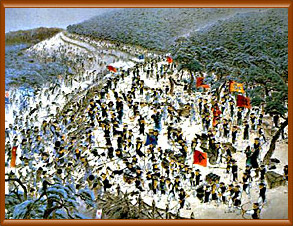Re-grouping of Government Forces and Counterattack
Most of the country, other than the Honam area, was in the control of the enemy only one month after the commencement of the invasion by the Japanese forces, and King Seonjo was placed in great threat in Uiju, and the Royal Court of Joseon requested Ming Dynasty for rescue.
Ming Dynasty had many disputes for dispatching its forces, but it felt that Joseon's safety would be important for its own security with the premises of Japan for 'Gadoipmyeong', particularly after the fall of Pyeongyang, and it came to dispatch the rescue force. At first, it sent five thousand soldiers, led by Yoyangbuchongbyueong Jo Seung-hoon. However, on July 15, 1592, the military force of Ming attacked Japanese forces at stormy night on Pyeongyang Fortress, but the Japanese forces encountered with ambush to defeat the military force of Ming.
With this battle as the turning point, Ming Dynasty and Japan began to negotiate for truce. Gonisi requested for negotiation for truce two times while it encountered the Joseon forces at Imjingang but he sought for truce with Ming Dynasty as the military force of Ming came into Joseon. As Ming Dynasty was defeated in the first encounter, it attempted to agree to the Japanese invader not to invade farther north of Pyeongyang and the Joseon forces not to be in operation on the southern part.
In the meantime, as the first attempt of relief by Ming Dynasty failed, Ming Dynasty had the divided opinion of making the truce and the opinion to dispatch forces, but it was determined for dispatching the second rescue forces. In December 1592, Lee Yeo-song led 43,000 soldiers to come to Joseon.
 The battle of Pyeongyang Fortress
The battle of Pyeongyang Fortress
In the meantime, General Gwon Yul of Joseon encountered with a major Japanese force at Haengju Fortress and defeated it for one of the greatest victories in the war. This battle was referred to as one of the three greatest victories of Imjin War along with the Jinju Battle of Kim Si-min and the Battle of Hansando of Yi sun-shin.
 The battle of Haengju Fortress
The battle of Haengju Fortress